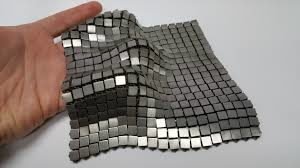
There are currently more dimensions than Star Trek even dared voyage to in the story of where NASA’s innovations are going using 3D printing tools to elevate the aviation industry into the 21st century.
From new composite materials to new metal printing that’s unavailable to the commercial market, rapidly advanced prototypes and elegant material design to mention just a few, NASA at the very forefront of the seemingly new but quite old phenomenon called ‘additive manufacturing’.
NASA got involved in the arena at a very early stage and was an adopter before other manufacturers could get their hands on any functional 3D printer.
When Chuck Hull made the initial breakthrough in 3D printing, we were in the Ronald Reagan Era in the 1980’s and when many had no idea how to interpret the breakthrough NASA was quick on the uptake of plastic prototyping which is the ethos behind 3D printing as opposed to what we use every day such as toner cartridges. As early as 2001 NASA has accomplished a breakthrough in making a large metal production 3D machine for research purposes.
Development commenced during the 1990’s with a technology known then as (LENS) Laser Engineering Net Shaping. The functionality was a laser beam being fed metallic powder to create layers in three dimensions, and just to think at this time major breakthroughs in the commercial market were Brother Toner cartridges.
Although tedious in timing the results were precise, and the bug caught on with NASA’s aeronautics researchers but alas technology moved on, and LENS was a thing of the past but served a purpose in the progression and an insight into what could be.
Evolution to Multi-Dimensional Benefits for the Aerospace Industry
As in all manufacturing processes, two elements are crucial speed and size.
Enter the (EBF3) Electron Beam Freeform Fabrication; it’s star quality, an electron beam directed at the material with less reflection.
What we now call 3D printing became clear to NASA in the first decade of the new century and how widespread the usage of the EBF3 could be.
3D printing is able to not only produce complex parts easier and quicker than conventional methods, but it’s also now able to create pieces that aren’t even in the wheelhouse of traditional manufacturing AT ALL.
This is the Holy Grail for manufacturers in general, speed and cost-cutting. Something that takes less time, uses less material, costs less to produce and produces a product higher quality is a dream come true. If that wasn’t enough let us throw in the fact that’s it’s way more environmentally friendly than traditional manufacturing just when our planet needs it. This really is a home run for NASA and global production as a whole.
Cutting Down Components and Waste
With 3D printing taking centre stage it is highlighting more and more where manufacturing is in need of a complete overhaul.
Take the manufacture of components for an aeroplane. If 350lbs of titanium parts are required, they will then need assembling. The necessary starting weight before processing and cutting even begins is a 7000lbs block of titanium.
The next step is the formation and machine cut down into the required shapes and sizes. Throughout this process hundreds of gallons of coolant are used, and you are then left with 6650lbs of titanium chips and pieces, which themselves then require recycling, adding more cost, time and emissions to the procedure.
The game-changer of 3D printing is that components can be made whole without a compromise in overall strength and now to some extent flexibility. Take a wing of an aeroplane for example and think about the manufacturing process differential of it being made as one whole part instead of smaller parts that then need a numerous manual and machinery workforce to assemble.
With different compositions of metal alloys now being created, these can be added in certain spots for strengthening and lead to weight saving in other areas and of course with fewer components needing to be welded or bolted together safety is another factor as there are fewer opportunities for the formation of cracks and separation.
GE Makes the Breakthrough for Commercial Flight
Outside of aerospace GE released a 3D printed aviation engine early in 2018 that was successfully tested in Prague, Czech Republic. The Advance Turbo Prop Engine reduced the parts of the engine from a staggering 855 separate components into just 12! If this wasn’t enough reduced the overall weight by over 100lbs and improved fuel consumption by a mind-blowing 20 per cent with additional benefits as well as maintenance simplification, so it’s hard to ignore where the industry is headed in the next decade especially with the world so environmentally conscious.
The Safety Certification Conundrum
The main hurdle to bring 3D printing into the mainstream right now especially in the United States is legislation and safety regulations.
Of course anything that NASA in Aerospace or GE and Airbus and Boeing in commercial aviation are working on is undoubtedly to the highest safety standards possible. However, for the smaller to medium sized enterprises (SMEs) looking to use 3D printing in mainstream production this is where their growth has stalled somewhat.
However, recent moves by the Federal Aviation Administration (FAA) to become active in new certification processes is a step in the right direction towards certifying a whole range of parts and components for use.
However, as things stand the FAA has only certified three structural 3D printed metallic parts none of which within the industry are considered critical to safety.
This is a prime example of where we saw private investment dry up around six to seven years ago and many venture capital companies looked to invest elsewhere and slowly but surely 3D printing faded from the public psyche and ran comparisons with the initial .com boom and bust.
The 3D industry is on the comeback though. In a similar way to global warming 10 years ago many people had an argument that there was insufficient proof for them to change certain practices, (the same applied in manufacturing) but now it is barely deniable, the same as what 3D printing is now, it’s a technology that just cannot be ignored any longer.
Composite 3D Printing
While NASA is working closely with the FAA to certify techniques the other side of the industry is studying what composite materials can 3D printing process and produce, and right now the boundaries look endless.
They are testing carbon nanotubes that can bring:
. Lighter Load for airlines
. Rigid and robust composite – high safety grade
. Thermal properties
. Electrical saving properties
By combining the carbon with a plastic material the result is a composite multi-functional material, and as with all new technologies looks to be just the tip of the iceberg.
Conclusion
With the aerospace, aviation, medical and dentistry industries leading the way in current usage of 3D technologies and with many large corporations starting to invest heavily in research and development, addictive manufacturing’ is no longer a hype job it is a reality. With testing underway and many more exciting and previously untested combinations of liquids, metals, alloys, plastics and other materials underway, the future of manufacturing is looking at going through a transition similar to what we have and are witnessing in the printing industry fighting to go from traditional print to digital. The next ten years of 3D printing are certainly going to be in the public consciousness a lot more than the previous 10.
Author Bio
 David Blakey is a seasoned tech writer. He likes writing about computer gadgets, printers and other electronic devices. He is associated Hottoner who are suppliers of Brother mfc-9330cdw toner cartridges.
David Blakey is a seasoned tech writer. He likes writing about computer gadgets, printers and other electronic devices. He is associated Hottoner who are suppliers of Brother mfc-9330cdw toner cartridges.
Leave a Reply